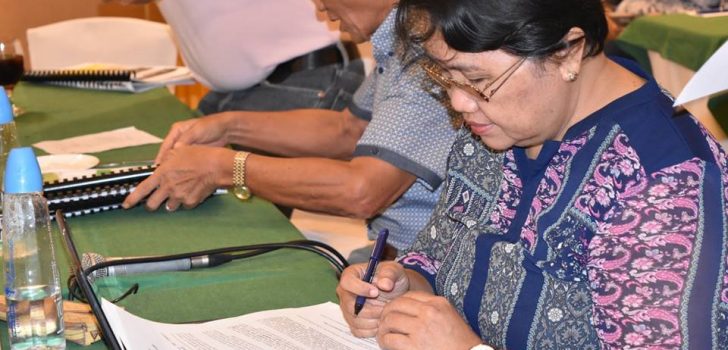 Engr. Remelyn R. Recoter, Department of Agriculture Regional Office 6 director and Project Director of the Project Support Office Visayas Cluster, signs the resolution approving the different projects lined up for the provinces of Guimaras and Negros Occidental.
Engr. Remelyn R. Recoter, Department of Agriculture Regional Office 6 director and Project Director of the Project Support Office Visayas Cluster, signs the resolution approving the different projects lined up for the provinces of Guimaras and Negros Occidental. Seaweeds dryers, feeder port projects lined up for Region 6
ILOILO City – The Regional Project Advisory Board (RPAB) on Sept. 3 approved the construction of subprojects in Guimaras and Negros Occidental provinces under the Department of Agriculture-Philippine Rural Development Project (DA-PRDP).
Lined up were a feeder port breaker/rock causeway worth P154,171,142.00 in Sagay City, Negros Occidental and 10 seaweeds dryers cum storage facilities worth P10,903,958.43 in Guimaras.
SAGAY FEEDER PORT/FISH LANDING
“We have noted the congestion in the port in Manila, which eventually affects the country’s economy as only lesser goods and services are delivered in and out of the country,” said Dr. Narissa Lemoncito, Provincial Project Management and Implementation Unit (PPMIU) Negros Occidental assistant head.
Their study, Lemoncito said, concluded that one of the solutions is the opening of new shipping routes to relieve this congestion, with the Sagay City–Batangas City direct route as a possible solution to lessen the problem.
“Different goods are delivered to the province of Negros Occidental mainly through roll on-roll off vessels that ply the Mindoro-Caticlan-Dumangas-Bacolod route. This long route requires longer travel time by land and sea. Because of that, we proposed the Sagay City-Batangas City direct route,” she said.
There is already an existing port in Sagay City that connects directly to the Batangas City port. Most vessels that dock here, however, are small crafts that ply the Bantayan Island-Sagay City route. At least once in a month, vessels that unload coal and load mined silica also dock in the existing port.
“With the completion of this feeder port breaker/rock causeway project, goods loaded on trucks or vans from Batangas City can be transported directly to Sagay City. The same will happen for goods to be transported from Sagay City to Batangas City,” said Lemoncito.
The shorter route will lessen travel time by sea and will be highly beneficial to shippers in Northern Negros—Cadiz City, Manapla, Escalante City, Toboso, Calatrava and San Carlos City, she said.
It will also benefit residents, mostly farmers, fisherfolk and laborers, from Old Sagay, Molacaboc, Suyac, Panal Reef, Carbin Reef, Bantayan Island, Cebu, Estancia and Macahulom Island.
“The proposed route is estimated at 265 nautical miles, and will pass by Romblon. But there is the necessity of improving the existing Sagay City feeder port. This will involve dredging, extending of causeway and construction of wharf for hull type vessels and constructions of breakwaters,” she added.
The proposed port improvement is also seen to open economic opportunities for Sagay City and Northen Negros. Sugar produced by three sugar mills in Sagay City can be easily transported Metro Manila, other Visayan islands and to southern provinces of Luzon. The mining industry, especially silica, will also be given a big boost.
“With these opportunities, the project can contribute to the economic growth of Sagay City and Northern Negros. This will enhance economic activities through commerce and trade. It will pave the way for agro-tourism because of the the existing marine sanctuary, plus the organic farming in the highlands of Sagay,” said Lemoncito.
GUIMARAS SEAWEEDS DRYER CUM STORAGE
Meanwhile, four facilities that will provide post-harvest support for seaweeds farmers will be put up in Guimaras.
“Our island province is surrounded by bodies of water. Its coastline covers some 470.29 kilometers, and its coastal ecosystem is rich and diverse,” said Ma. Cecilia Farrol, focal person of the Global Environment Facility project in Guimaras.
She said that in Western Visayas, the province—with some 451 seaweed growers—ranks second to Antique in seaweed production.
“But when we prepared our value chain analysis, we noted the lack of drying and storage facilities. As such, there is a need to build seaweeds dryers cum storage facilities to improve our post-harvest practices. We incorporated this in our Provincial Commodity Investment Plan,” said Farrol.
The project will provide post-harvest support to the following associations: Sibunag Seaweed Production and Marketing Enterprise and Panobolon Unified Fisherfolk Association Seaweed Production and Marketing.
The facilities will be built in Sabang, Sibunag (3); Sebaste, Sibunag (2); San Isidro, Sibunag (2); and Panobolon, Nueva Valencia (3).
“Once completed, the project is expected to ensure that the dried, raw seaweeds are of high quality and are free from extraneous materials like sand, stones and other contaminants,” Farrol said. “The seaweeds that have been dried in the facilities will also have a rubber-like texture with no discoloration and have 35% or lower moisture content.”
Seaweeds of that quality, Farrol said, have a higher market price. And with these facilities, there is an expected savings due to the reduction of post-harvest losses—specifically losses during field processing or drying—and the reduction in the wastage of the product. This will translate to additional income for seaweeds farmers.
Also approved during the RPAB meeting was the amendment of the title and approval of the resolution of Goat Breeding, Milk Production and Marketing Enterprise, and the approval of the resolution for Blue Swimming Crab Rehabilitation and Fish Trading Support/Tortosa Pumpboat Association of Manapla, Negros Occidental; and Rehabilitation of Abaca Nursery of the Dumangsal Farmers Association of Barangay Embrangga-an, Barbaza, Antique. (John Paul Cadiz, Writer, RPCO 6)
